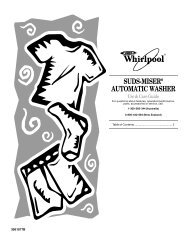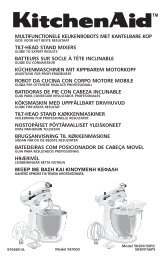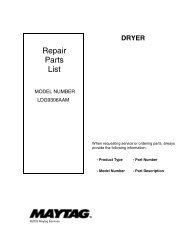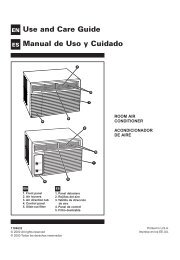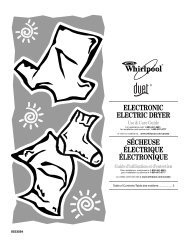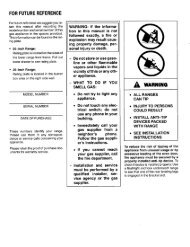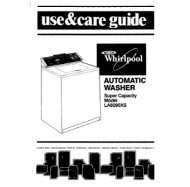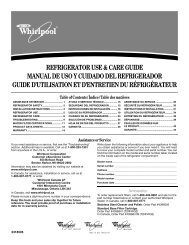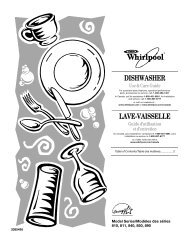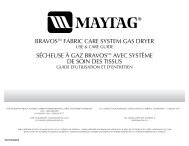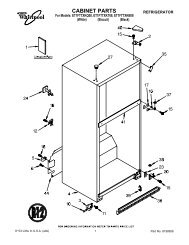refrigerator use & care guide manual de uso y cuidado del ...
refrigerator use & care guide manual de uso y cuidado del ...
refrigerator use & care guide manual de uso y cuidado del ...
Create successful ePaper yourself
Turn your PDF publications into a flip-book with our unique Google optimized e-Paper software.
8<br />
Adjusting Controls<br />
The mid-settings indicated in the previous section should be<br />
correct for normal ho<strong>use</strong>hold usage. The controls are set correctly<br />
when milk or juice is as cold as you like and when ice cream is<br />
firm.<br />
If the temperature is too warm or too cold in the <strong>refrigerator</strong> or<br />
freezer, first check the air vents to be sure they are not blocked.<br />
If you need to adjust temperatures, <strong>use</strong> the settings listed in the<br />
chart below as a <strong>gui<strong>de</strong></strong>. On mo<strong>de</strong>ls with two controls, adjust the<br />
<strong>refrigerator</strong> temperature first. Wait at least 24 hours between<br />
adjustments and then recheck the temperatures.<br />
CONDITION/REASON: ADJUSTMENT:<br />
REFRIGERATOR too warm REFRIGERATOR or<br />
TEMPERATURE Control one<br />
setting higher<br />
FREEZER too warm/too<br />
little ice<br />
Crisper Humidity Control<br />
(on some mo<strong>de</strong>ls)<br />
You can control the amount of humidity in the moisture-sealed<br />
crisper. Adjust the control to any setting between LOW and HIGH.<br />
LOW (open) for best storage of fruits and vegetables with skins.<br />
HIGH (closed) for best storage of fresh, leafy vegetables.<br />
Ice Maker<br />
Turning the Ice Maker On/Off<br />
FREEZER or TEMPERATURE<br />
Control one setting higher<br />
MAX ice production switch<br />
REFRIGERATOR too cold REFRIGERATOR or<br />
TEMPERATURE Control one<br />
setting lower<br />
FREEZER too cold FREEZER or TEMPERATURE<br />
Control one setting lower<br />
To turn the ice maker ON, simply lower the wire shutoff arm.<br />
To <strong>manual</strong>ly turn the ice maker OFF, lift the wire shutoff arm to the<br />
OFF (arm up) position and listen for the click.<br />
NOTE: Your ice maker has an automatic shutoff. As ice is ma<strong>de</strong>,<br />
the ice cubes will fill the ice storage bin and the ice cubes will<br />
raise the wire shutoff arm to the OFF (arm up) position. Do not<br />
force the wire shutoff arm up or down.<br />
Ice Production Rate<br />
■ Allow 24 hours to produce the first batch of ice. Discard the<br />
first three batches of ice produced.<br />
■ The ice maker should produce approximately 8 to 12 batches<br />
of ice in a 24-hour period.<br />
■ To increase ice production, lower the freezer and <strong>refrigerator</strong><br />
temperature. See “Using the Controls.” Wait 24 hours<br />
between adjustments.<br />
■ For maximum ice production (on some mo<strong>de</strong>ls), push the<br />
switch to ICE PLUS. The ice maker should produce 16 to<br />
20 batches of ice in a 24-hour period in the Ice Plus mo<strong>de</strong>.<br />
Remember<br />
■ The quality of your ice will be only as good as the quality of the<br />
water supplied to your ice maker. Avoid connecting the ice<br />
maker to a softened water supply. Water softener chemicals<br />
(such as salt) can damage parts of the ice maker and lead to<br />
poor quality ice. If a softened water supply cannot be avoi<strong>de</strong>d,<br />
make sure the water softener is operating properly and is well<br />
maintained.<br />
■ Do not <strong>use</strong> anything sharp to break up the ice in the bin. This<br />
can ca<strong>use</strong> damage to the ice container and the dispenser<br />
mechanism.<br />
■ Do not store anything on top of or in the ice maker or ice bin.<br />
REFRIGERATOR CARE<br />
Cleaning<br />
WARNING<br />
Explosion Hazard<br />
Use nonflammable cleaner.<br />
Failure to do so can result in <strong>de</strong>ath, explosion, or fire.<br />
Both the <strong>refrigerator</strong> and freezer sections <strong>de</strong>frost automatically.<br />
However, clean both sections about once a month to prevent<br />
odors from building up. Wipe up spills immediately.<br />
IMPORTANT: Beca<strong>use</strong> air circulates between both sections, any<br />
odors formed in one section will transfer to the other. You must<br />
thoroughly clean both sections to eliminate odors. To prevent<br />
odor transfer and drying out of food, wrap or cover foods tightly.<br />
To Clean Your Refrigerator:<br />
NOTE: Do not <strong>use</strong> abrasive or harsh cleaners such as window<br />
sprays, scouring cleansers, flammable fluids, cleaning waxes,<br />
concentrated <strong>de</strong>tergents, bleaches or cleansers containing<br />
petroleum products on plastic parts, interior and door liners or<br />
gaskets. Do not <strong>use</strong> paper towels, scouring pads, or other harsh<br />
cleaning tools.<br />
1. Unplug <strong>refrigerator</strong> or disconnect power.<br />
2. Hand wash, rinse, and dry removable parts and interior<br />
surfaces thoroughly. Use a clean sponge or soft cloth and a<br />
mild <strong>de</strong>tergent in warm water.<br />
3. Wash stainless steel and painted metal exteriors with a clean<br />
sponge or soft cloth and a mild <strong>de</strong>tergent in warm water.



